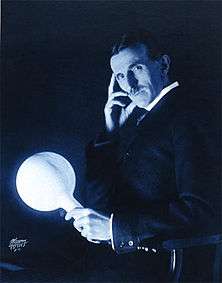Tesla valve
A Tesla valve, called by Tesla a valvular conduit, is a fixed-geometry passive check valve. It allows a fluid to flow preferentially in one direction, without moving parts. The device is named after Nikola Tesla, who was awarded U.S. Patent 1,329,559 in 1920 for its invention. The patent application describes the invention as follows:[1]
The interior of the conduit is provided with enlargements, recesses, projections, baffles, or buckets which, while offering virtually no resistance to the passage of the fluid in one direction, other than surface friction, constitute an almost impassable barrier to its flow in the opposite direction.

Tesla illustrates this with the drawing, showing one possible construction with a series of eleven flow-control segments, although any other number of such segments could be used as desired to increase or decrease the flow regulation effect.
One computational fluid dynamics simulation of Tesla valves with two and four segments showed that the flow resistance in the blocking (or reverse) direction was about 15 and 40 times greater, respectively, than the unimpeded (or forward) direction.[2] This lends support to Tesla's patent assertion that in the valvular conduit in his diagram, a pressure ratio "approximating 200 can be obtained so that the device acts as a slightly leaking valve".[1]
The Tesla valve is used in microfluidic applications[3] and offers advantages such as scalability, durability, and ease of fabrication in a variety of materials.[4]
Diodicity
The valves are structures that have a higher pressure drop for the flow in one direction (reverse) than the other (forward). This difference in flow resistance causes a net directional flow rate in the forward direction in oscillating flows. The efficiency is often expressed in diodicity , being the ratio of pressure drops for identical flow rates:[5]
where is the reverse flow pressure drop, and the forward flow pressure drop for flow rate .
See also
- Coanda effect
- Diode
- Labyrinth seal
- Static mixer
References
- "Patent #: US001329559". United States Patent and Trademark Office. Office of the Chief Communications Officer. Retrieved 2 January 2017.
- "Tesla's Valvular Conduit - Fluid Power Journal". Fluid Power Journal. 2013-10-23. Archived from the original on 2017-01-13. Retrieved 2017-01-13.
- Deng, Yongbo; Liu, Zhenyu; Zhang, Ping (28 Jan 2010). "Optimization of no-moving part fluidic resistance microvalves with low reynolds number". Micro Electro Mechanical Systems (MEMS), 2010 IEEE 23rd International Conference on: 67–70. doi:10.1109/MEMSYS.2010.5442565. ISBN 978-1-4244-5761-8.
- Gamboa, Adrian R.; Morris, Christopher J.; Forster, Fred K. (2005). "Improvements in Fixed-Valve Micropump Performance Through Shape Optimization of Valves". Journal of Fluids Engineering. 127 (2): 339. doi:10.1115/1.1891151.
- de Vries; Florea; Homburg; Frijns (2017). "Design and operation of a tesla-type valve for pulsating heat pipes". International Journal of Heat and Mass Transfer. 105: 1–11. doi:10.1016/j.ijheatmasstransfer.2016.09.062.
